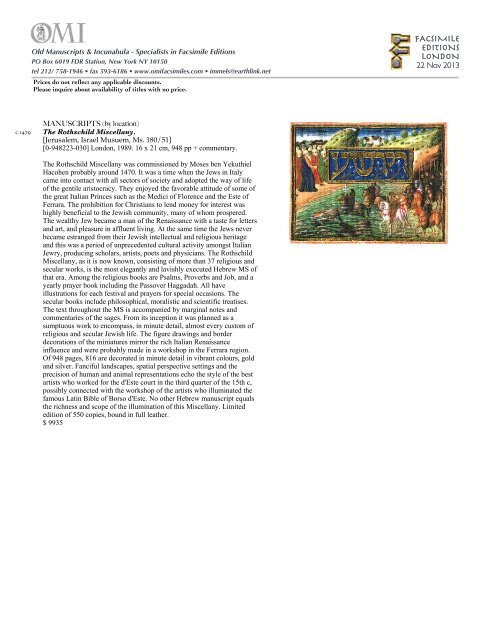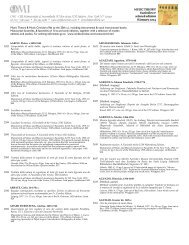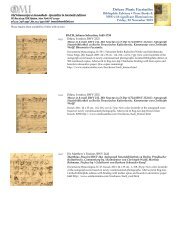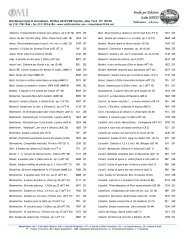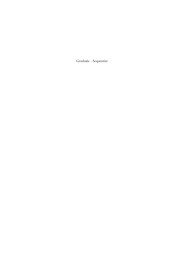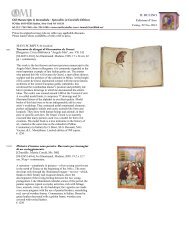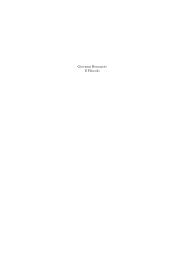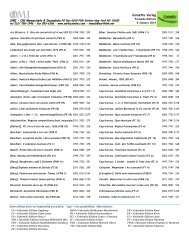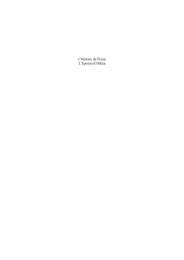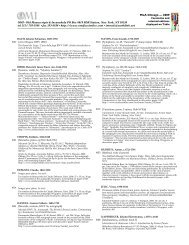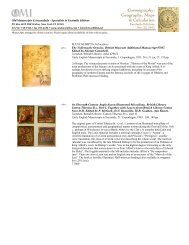Facsimile Editions London - OMI - Old Manuscripts & Incunabula
Facsimile Editions London - OMI - Old Manuscripts & Incunabula
Facsimile Editions London - OMI - Old Manuscripts & Incunabula
Create successful ePaper yourself
Turn your PDF publications into a flip-book with our unique Google optimized e-Paper software.
<strong>Old</strong> <strong>Manuscripts</strong> & <strong>Incunabula</strong> - Specialists in <strong>Facsimile</strong> <strong>Editions</strong><br />
PO Box 6019 FDR Station, New York NY 10150<br />
tel 212/ 758-1946 • fax 593-6186 • www.omifacsimiles.com • immels@earthlink.net<br />
Prices do not reflect any applicable discounts.<br />
Please inquire about availability of titles with no price.<br />
FACSIMILE<br />
EDITIONS<br />
LONDON<br />
22 Nov 2013<br />
MANUSCRIPTS (by location)<br />
c.1479 The Rothschild Miscellany.<br />
[Jerusalem, Israel Musuem, Ms. 180/51]<br />
[0-948223-030] <strong>London</strong>, 1989. 16 x 21 cm, 948 pp + commentary.<br />
The Rothschild Miscellany was commissioned by Moses ben Yekuthiel<br />
Hacohen probably around 1470. It was a time when the Jews in Italy<br />
came into contact with all sectors of society and adopted the way of life<br />
of the gentile aristocracy. They enjoyed the favorable attitude of some of<br />
the great Italian Princes such as the Medici of Florence and the Este of<br />
Ferrara. The prohibition for Christians to lend money for interest was<br />
highly beneficial to the Jewish community, many of whom prospered.<br />
The wealthy Jew became a man of the Renaissance with a taste for letters<br />
and art, and pleasure in affluent living. At the same time the Jews never<br />
became estranged from their Jewish intellectual and religious heritage<br />
and this was a period of unprecedented cultural activity amongst Italian<br />
Jewry, producing scholars, artists, poets and physicians. The Rothschild<br />
Miscellany, as it is now known, consisting of more than 37 religious and<br />
secular works, is the most elegantly and lavishly executed Hebrew MS of<br />
that era. Among the religious books are Psalms, Proverbs and Job, and a<br />
yearly prayer book including the Passover Haggadah. All have<br />
illustrations for each festival and prayers for special occasions. The<br />
secular books include philosophical, moralistic and scientific treatises.<br />
The text throughout the MS is accompanied by marginal notes and<br />
commentaries of the sages. From its inception it was planned as a<br />
sumptuous work to encompass, in minute detail, almost every custom of<br />
religious and secular Jewish life. The figure drawings and border<br />
decorations of the miniatures mirror the rich Italian Renaissance<br />
influence and were probably made in a workshop in the Ferrara region.<br />
Of 948 pages, 816 are decorated in minute detail in vibrant colours, gold<br />
and silver. Fanciful landscapes, spatial perspective settings and the<br />
precision of human and animal representations echo the style of the best<br />
artists who worked for the d'Este court in the third quarter of the 15th c,<br />
possibly connected with the workshop of the artists who illuminated the<br />
famous Latin Bible of Borso d'Este. No other Hebrew manuscript equals<br />
the richness and scope of the illumination of this Miscellany. Limited<br />
edition of 550 copies, bound in full leather.<br />
$ 9935
<strong>OMI</strong> - <strong>Old</strong> <strong>Manuscripts</strong> & <strong>Incunabula</strong> • tel 212/ 758-1946 • fax 593-6186 • www.omifacsimiles.com • immels@earthlink.net <strong>Facsimile</strong> <strong>Editions</strong>, p.2<br />
1479 The Rothschild Haggadah. A Passover Compendium from the<br />
Rothschild Miscellany.<br />
[Jerusalem, Israel Musuem]<br />
[0-948223-189] <strong>London</strong>, 2000. 16 x 21 cm, 2 vols, 44, 79 pp.<br />
Commissioned by Moses ben Yekutiel Hacohen and written and<br />
decorated in northern Italy in 1479, this Haggadah is unrivalled in<br />
richness and scope. Although medieval haggadahs are among the most<br />
extensively decorated of all types of Hebrew MSS, the Rothschild<br />
Haggadah, stands out for its elegant and elaborate illustrations of the<br />
Passover story and the richness of its marginal texts. The MS comprises<br />
the Ashkenazi Passover eve service as we know it today (except for<br />
Grace after Meals which was deliberately omitted by the scribe),<br />
provided as the main text in the center of the page. In the margins is<br />
Maimonides' Hilkhot Hamez Umatsah ("Laws Concerning Leavened and<br />
Unleavened Bread"), a classical survey of Passover and its ceremonies.<br />
In addition the book includes the section devoted to the piyyutim—the<br />
liturgical poems and songs—for all four evenings of the festival of<br />
Passover, also exquisitely illuminated; in its margin one finds a medieval<br />
text on weights and measures. Commentary and translations by Raphael<br />
Loewe, Jeremy Schonfield & Iris Fishof. Limited edition of 550 copies,<br />
bound in full vellum, with slipcase.<br />
$ 850<br />
c.1280 The North French Hebrew Miscellany.<br />
[<strong>London</strong>, British Library, Add. 11639]<br />
[0-948223-219] <strong>London</strong>, 2005. 12.5 x 16 cm, 1494 pp + commentary.<br />
MS Add. 11639, written and illustrated in northern France around 1280<br />
(possibly in the environs of Troyes), is of profound importance in the<br />
history and culture of the Jewish people. Its contents are rich and varied,<br />
with altogether 84 different groups of texts, including hundreds of poems.<br />
These include the Pentateuch and Haftarot (readings from the Prophets),<br />
Song of Songs and several other biblical texts; the daily, Sabbath and<br />
festival prayers, including those for Rosh Hashanah and Yom Kippur;<br />
Grace after Meals; Pirkei Avot (Ethics of the Fathers); assorted legal<br />
codes and formulae for agreements concerning marriage, divorce and<br />
business partnerships; an arithmetical riddle; laws governing Tefilin,<br />
Ritual Slaughter and an abundance of other texts including the Mezuzah;<br />
the Hebrew version of the Book of Tobit (the earliest extant copy<br />
known), a wide range of medieval poetry and Isaac de Corbeil's Sefer<br />
Mitsvot Katan (also the earliest known copy, composed 1277). The codex<br />
is a masterpiece of its time and place, bearing witness to the artistic<br />
quality achieved in northern France at this period. Benjamin the Scribe<br />
collaborated with artists whose skills are comparable with those makers<br />
of the finest contemporary Gothic manuscripts. The numerous full-page<br />
miniatures illustrate famous scenes from the Bible, and marginal<br />
decorations, with their constantly varying arabesques, grotesques,<br />
flowers, animals, birds and fishes, adorn virtually every folio.<br />
Commentary by Jeremy Schonfield with contributions by Diana<br />
Rowland-Smith, & Raphael Loewe. Limited edition of 500 copies, bound<br />
in full leather.<br />
$ 8995
<strong>OMI</strong> - <strong>Old</strong> <strong>Manuscripts</strong> & <strong>Incunabula</strong> • tel 212/ 758-1946 • fax 593-6186 • www.omifacsimiles.com • immels@earthlink.net <strong>Facsimile</strong> <strong>Editions</strong>, p.3<br />
14th c.<br />
The Barcelona Haggadah.<br />
[<strong>London</strong>, British Library, Add. 14761]<br />
[0-948223-081] <strong>London</strong>, 1992. 19 x 26 cm, 322 pp + commentary.<br />
The Barcelona Haggadah, created around 1350 and named after the<br />
heraldic shield it bears resembling the arms of Barcelona, is recognized<br />
as one of the finest illuminated Hebrew MSS in the British Library.<br />
When it was created the Jews of Aragon and Catalonia formed one of the<br />
largest communities in Europe, and Barcelona was home to a flourishing<br />
center of book illumination linked to the Court and influenced by Italian<br />
and French styles. Of all categories of Jewish prayer book the Passover<br />
Haggadah tends to be the most extensively and richly decorated. The<br />
narrative itself, the Rabbinic elaboration, the family meal, the symbolic<br />
foods and the fact that the story is told to children, provide added<br />
incentives for colorful elaboration. Even the size of the MS lends itself to<br />
be used and enjoyed at the Passover table on the eve of the festival for<br />
the family gathering known as the Seder. This Haggadah is outstanding<br />
for its rich decorative and representational art scattered throughout the<br />
text. 128 of its 322 pages are richly ornamented with fanciful figures and<br />
pictorial scenes that provide fascinating insights into Jewish life in<br />
medieval Spain. For instance, music and culture in general flourished in<br />
Barcelona and its environs, and the Jewish community was proud to be<br />
fully involved. Indeed, until the forced conversion of the Jewish<br />
population of Barcelona in 1401, Jewish musicians played a vital role in<br />
drawing the Jews and Christians closer together. It is not surprising,<br />
therefore, that a lively interest in music is clearly displayed throughout<br />
the MS: in all, twenty-eight different instruments appear in the<br />
illustrations. More intimate details, such as the pictures of the meal, take<br />
us straight into a Jewish home of the period, while the synagogue scene<br />
reflects 14th-c. conditions and traditions. The illustrations of the five<br />
rabbis of Bnei Brak, the four sons, the story of Abraham breaking the<br />
idols, and the Exodus (which is shown taking place on horseback in<br />
medieval costume), are of great historical value. The unrestrained humor<br />
of the artist is clear from the dogs and rabbits that romp through the<br />
pages of the MS. Commentary by Jeremy Schonfield, Raphael Loewe,<br />
David Goldstein, & Malachi Beit-Arie. Limited edition of 500 copies,<br />
bound in leather.<br />
$ 4810<br />
18th c.<br />
Perek Shirah.<br />
[<strong>London</strong>, British Library, or.54 (OR.12,983)]<br />
[0-948223-170] <strong>London</strong>, 1996. 8 x 13 cm, 2 vols, 34, 56 pp.<br />
This charming 18th-c. Hebrew and Yiddish MS was probably written by<br />
Aaron Wolf Schreiber Herlingen of Gewitsch in Vienna. Its vellum<br />
leaves contain exquisite miniatures of many of the “worshippers” within<br />
magnificent scenes from nature. The "Perek Shirah", a 10th-c. text,<br />
reflects an acute awareness of the spiritual dimension of nature and the<br />
environment. It is a cosmic hymn to the Creator in which all of creation,<br />
including the winds, clouds, all species of birds, mammals and fish sing<br />
praises for their very existence. It opens with the promise that those who<br />
recite it "are assured of a place in the World to Come" and ends with the<br />
hope that their study will be transformed into good deeds that will win<br />
heavenly reward. The praises are expressed in the form of scriptural<br />
quotations, reflecting the Jewish belief in the interdependence of study<br />
and prayer. Commenatary by Malachi Beit-Arié and Emile Schrijver,<br />
including a translation of the text by Jeremy Schonfield. Limited edition<br />
of 550 copies, bound in aged vellum and tooled after the original, housed<br />
in hand-marbled slipcase.
<strong>OMI</strong> - <strong>Old</strong> <strong>Manuscripts</strong> & <strong>Incunabula</strong> • tel 212/ 758-1946 • fax 593-6186 • www.omifacsimiles.com • immels@earthlink.net <strong>Facsimile</strong> <strong>Editions</strong>, p.4<br />
8th-<br />
12th c.<br />
Torah Scroll.<br />
[<strong>London</strong>, Jews’ College]<br />
<strong>London</strong>, 1985. 115 x 50 cm, scroll mounted on board.<br />
One of the oldest extant fragments of a Torah scroll. Although the date<br />
and country of origin is unknown, it is believed that this fragment<br />
originated from the Middle East and was written between the 8th and<br />
12th centuries. Written on leather, it was found in the Cairo Geniza and is<br />
now held in the library of Jews' College. Each facsimile is supplied<br />
float-mounted on acid-free mount board and set in an elegant polished<br />
wood frame in dark oak with a discreet gold insert on the inner edge.<br />
Includes a message from Chief Rabbi Jonathan Sacks and a full<br />
description of the manuscript. Each facsimile is individually numbered<br />
on a brass plaque.<br />
$ 2300<br />
18th c.<br />
Me’ah Berakhot. One Hundred Blessings. An Illustrated<br />
Miniature Liturgical Compendium in Hebrew and Yiddish<br />
from 18th-Century Central Europe.<br />
[New York, private collection]<br />
[0-948223-146] <strong>London</strong>, 1994. 4 x 4.5 cm, 2 vols, 74, 109 pp.<br />
This little book, in miniature format, is a remarkable example of the<br />
revival of Hebrew MS illumination in the 18th c. At that time, long after<br />
the invention of printing, it was recognized that a handwritten and finely<br />
illustrated book offered a sense of luxury and respect for religious ritual.<br />
Although the original (from central Europe) is now in the possession of a<br />
private collector in New York, the present facsimile edition makes it<br />
"accessible" again to connoisseurs of Jewish booklore and culture.<br />
Traditionally, pious Jews seek to recite blessings on at least 100<br />
occasions daily. This unique MS of the Me'ah Berachot (the title means<br />
"one hundred blessings"), is a compendium of such blessings, each<br />
allocated to a time of day or to a special event. It gathers together<br />
morning prayers, Grace after Meals, prayers on retiring at night, (Qriat<br />
Sh'ema), petitions for the safety of travellers and many other texts to be<br />
recited at particular moments—on seeing a beautiful tree, on hearing<br />
thunder or on wearing a new garment for the first time. Since it also<br />
includes three blessings specifically related to womanly duties (mitzvoth<br />
nashim)—on breadmaking, ritual bathing and kindling the Sabbath<br />
lights—the book was probably commissioned as a special gift to a<br />
woman. Such a splendid prayer book may well have been presented to a<br />
bride. Indeed it is a miniature handbook of Jewish life intended for Jews<br />
of all ages. Besides the beautifully written script, the MS contains an<br />
illuminated title-page and 29 miniature panels illustrating some of the<br />
activities associated with the blessings included. Each painting is headed<br />
by a cartouche containing the relevant blessing, preceded by directions<br />
on how to recite it, written in a more cursive Yiddish script. Three<br />
additional miniatures depict a variety of everyday genre scenes—lighting<br />
the Sabbath candles, family mealtimes, tending the garden, putting on<br />
new clothes, entering the ritual bath, and even the then common medical<br />
practice of bloodletting. Commentary by Iris Fishof. Limited edition of<br />
550 copies, printed on vellum and bound in leather with sterling<br />
ornaments.
<strong>OMI</strong> - <strong>Old</strong> <strong>Manuscripts</strong> & <strong>Incunabula</strong> • tel 212/ 758-1946 • fax 593-6186 • www.omifacsimiles.com • immels@earthlink.net <strong>Facsimile</strong> <strong>Editions</strong>, p.5<br />
1476 The Kennicott Bible. An Introduction by Bezalel Narkiss and<br />
Aliza Cohen-Mushlin.<br />
[Oxford, Bodleian Library, Kennicott 1]<br />
[0-948223-006] <strong>London</strong>, 1985. 26 x 32 cm, 922 pp + commentary.<br />
The Kennicott Bible is named after Benjamin Kennicott (1718-1783), the<br />
English Christian Hebraist who was educated and worked most of his life<br />
in Oxford. A Canon of Christ Church, Oxford, he continued the English<br />
tradition of studying the Hebrew bible. His pioneering work, comparing<br />
text variants of hundreds of Hebrew MSS worldwide, was published in<br />
his Dissertatio Generalis. In the course of his work he acquired this MS<br />
for the Radcliffe Library from where it was transferred to the Bodleian in<br />
1872. In 200 years, only 30 art historians and scholars have been<br />
privileged to study the Kennicott Bible, one of the Bodleian's greatest<br />
treasures. The Bible, together with Rabbi David Kimchi's grammatical<br />
treatise, was copied by the scribe Moses Ibn Zabara in 1476 at the<br />
commission of Isaac, the son of Don Solomon di Braga of La Coruña in<br />
northwestern Spain. Executed almost 20 years before the final expulsion<br />
of the Jews from Spain in 1492, at a time when they were already being<br />
harassed by the Spanish Inquisition, this MS shows what great<br />
importance the Jewish communities attached to the perpetuation of their<br />
heritage by investing in the production of an accurate and beautifully<br />
adorned Bible. From its inception the MS was planned as a lavish work<br />
as is witnessed in its 238 pages of illuminations, adorned with lively<br />
colors, burnished gold and silver leaf. The highly stylized<br />
figures—almost modern in their abstract rendering—delight the eye with<br />
the richness of their colors and varied compositions. The zoomorphic and<br />
anthropomorphic letters in the artist's colophon are a manifestation of his<br />
rich imagination. Joseph Ibn Hayyim created in his own individual and<br />
distinct style a unique masterpiece. King David on his throne, Jonah<br />
being swallowed by a fish, or Balaam as an astrologer consulting an<br />
astrolabe, are but a few of the text illustrations in the Kennicott Bible.<br />
Even Rabbi David Kimchi's grammatical treatise SEFER MIKHLOL was<br />
not copied as an austere text, but written within magnificently decorated<br />
arcaded pages, placed at the beginning and end of the Bible, possibly<br />
because the MS was commissioned for the youth, Isaac, in the hope that<br />
it might encourage his interest. Commentary by B. Narkiss & A.<br />
Cohen-Mushlin. Limited numbered edition of 500 copies, bound into a<br />
morocco goatskin box binding embossed on all sides.<br />
$ 9625
<strong>OMI</strong> - <strong>Old</strong> <strong>Manuscripts</strong> & <strong>Incunabula</strong> • tel 212/ 758-1946 • fax 593-6186 • www.omifacsimiles.com • immels@earthlink.net <strong>Facsimile</strong> <strong>Editions</strong>, p.6<br />
c.1280 The Parma Psalter.<br />
[Parma, Biblioteca Palatina, 1870 (de Rossi 510)]<br />
[0-948223-111] <strong>London</strong>, 1995. 10 x 13.5 cm, 452 pp + commentary.<br />
Among the nearly 1,650 Hebrew MSS housed in the Biblioteca Palatina<br />
in Parma that come down to us from the collection of the Christian<br />
Hebraist Giovanni Bernardo De Rossi (1742-1831 ), is MS 1870, a<br />
magnificent Psalter, written and decorated around 1280, possibly in<br />
Emilia in northern Italy. The work is one of the earliest and most<br />
important of all medieval Hebrew psalters. Its 452 pages contain the<br />
psalm texts in a clear, large vocalised Hebrew hand. Each chapter is<br />
illuminated and many are exquisitely illustrated with musical instruments<br />
or with scenes described in the text—extraordinary for a Hebrew<br />
manuscript of the period. Although its exact provenance is unknown it is<br />
clear that only a wealthy patron could have commissioned a MS so lavish<br />
and tasteful. Early copies of psalters with Abraham ibn Ezra's<br />
commentary on Psalms, as is the case here, are rare, and the Parma MS<br />
transmits interesting textual variants not found in the other versions. The<br />
illustrations in the MS—including numerous depictions of contemporary<br />
musical instruments—are particularly valuable for musicologists and art<br />
historians. In addition to the psalms one 8-page fascicle, added at a later<br />
date, contains the ceremonies for engagements, marriages, circumcisions<br />
and funerals, as well as for the end of a Sabbath followed by a Festival,<br />
times at which Psalms were especially recited. The rich decorations are<br />
characterized by the delicate use of harmonious colours; gold is used<br />
liberally but with sensitivity, the illuminator carefully balancing the<br />
Psalms and commentary with the images in the margin. Commentary,<br />
edited by Jeremy Schonfield, with contributions by Emmanuel Silver,<br />
Malachi Beit-Arié & Thérèse Metzger. Limited edition of 550 copies,<br />
bound in brown calfskin with gold stamping on the spine.<br />
$ 2700
<strong>OMI</strong> - <strong>Old</strong> <strong>Manuscripts</strong> & <strong>Incunabula</strong> • tel 212/ 758-1946 • fax 593-6186 • www.omifacsimiles.com • immels@earthlink.net <strong>Facsimile</strong> <strong>Editions</strong>, p.7<br />
18th c.<br />
Megillat Esther.<br />
[Tel Aviv, private collection William Gross]<br />
[0-948223-251] <strong>London</strong>, 2006. Scroll, 10.8 x 168 cm, 64 pp<br />
(commentary).<br />
Purim is a holiday of feasting and joy which celebrates the deliverance of<br />
the Jews of Persia during the reign of King Xerxes (485-465 BCE). The<br />
word Purim is derived from ‘Pur’ meaning lots, literally the lots cast by<br />
the Persians to decide when to execute the Jews. This story, recounted in<br />
the biblical book of Esther, is read publicly in synagogues each Purim.<br />
The reader recites it from a parchment scroll, known as a megillah. Over<br />
the centuries, Esther scrolls have become a symbol of celebration and<br />
continuity of Jewish life and they form the core of several major<br />
collections. The Gross family in Israel owns one of the finest collections<br />
in the world and their particular illuminated copy of the megillah is the<br />
basis of this facsimile edition. Written scrolls of Esther are not rare, but<br />
this megillah, written on fine parchment, is exceptional because the entire<br />
Purim story is illustrated in meticulous detail. Virtually every aspect of<br />
the Book of Esther is depicted in the miniature, where heroes and villains<br />
are playfully painted around the clear, square text to illustrate the victory<br />
of good over evil. There are scenes of baroque buildings and genteel<br />
characters in typical 18th-c. dress; even Haman’s sons hang in droll<br />
positions from the gallows. The wealth of detail contained within the<br />
intricately-drawn buildings and costumed figures adds weight to the<br />
theory that it was written in Germany around 1700. Although the exact<br />
date and location that the MS was commissioned remains a mystery, the<br />
words ‘STATT SHUSONN’ written in Latin letters above one of the<br />
illustrations at the beginning of the scroll reinforce the German<br />
provenance of the manuscript. Only one other Esther scroll, in the<br />
Library of the Jewish Theological Seminary in New York, is known to<br />
make use of Latin letters, and was written by the same scribe.<br />
Commentary by Emile Schrijver and Falk Wiesemann, with contribution<br />
by Muzi Wertheim and William Gross, edited by Jeremy Schonfield.<br />
Limited edition of 295 copies, printed on parchment and presented in a<br />
hand-tooled silver case.<br />
$ 3995
<strong>OMI</strong> - <strong>Old</strong> <strong>Manuscripts</strong> & <strong>Incunabula</strong> • tel 212/ 758-1946 • fax 593-6186 • www.omifacsimiles.com • immels@earthlink.net <strong>Facsimile</strong> <strong>Editions</strong>, p.8<br />
1422 The Alba Bible.<br />
[Toledo, Liria Palace, private collection, Duke of Alba]<br />
[84-60418-650] <strong>London</strong>, 1992. 1030 pp.<br />
The Alba Bible is not merely a superb example of Spanish book<br />
illumination, it is all that remains of one of the last attempts by<br />
intellectual Jews and Christians to heal the rifts that finally led to the<br />
calamity of expulsion. This facsimile was published as a tribute to and<br />
celebration of the reconciliation and renewal of understanding taking<br />
place in our own time. In 1422, during a lull in the often intensely<br />
anti-Jewish feeling in Spain, Don Luis de Guzmán, Grand Master of<br />
Calatrava, arrived at a decision that only by commissioning a Castilian<br />
Bible, translated by someone able to refer to the Hebrew and to compile a<br />
commentary reflecting the Jewish understanding of the texts, would<br />
Christians comprehend the differences between Christian and Jewish<br />
attitudes, and come to tolerate the other's views. Don Luis entrusted the<br />
work to Rabbi Moses Arragel who at first refused. By exposing the<br />
Jewish view he feared he might fuel antagonism towards Jews, and<br />
himself in particular. His protest sparked off a lively correspondence: the<br />
first 25 folios of the Alba Bible contain transcriptions of the detailed<br />
exchanges between the two men, documenting their negotiations up to<br />
the moment when the Rabbi finally agreed to take on the task. A number<br />
of Christian artists were employed to illustrate the text. What emerged is<br />
no less than a masterpiece. Known as the Alba Bible, after its eventual<br />
owner, it is the most important MS to have survived from the reign of<br />
King John II. Its 513 folios and 334 miniatures make it a powerful work<br />
of visual art but equally significant is the vast commentary it contains.<br />
Rabbi Moses showed great independence and courage, and his translation<br />
and commentary make few concessions to Christian thinking. It is rich in<br />
extracts not only from rabbinical writings such as the Targumim,<br />
Midrashim and Talmud, but also from later works such as the Zohar—the<br />
source book of Jewish mysticism. Rabbi Moses may well have given the<br />
artists detailed instructions on the illustrations, furnishing them with<br />
specifically Jewish interpretations of biblical scenes. The resulting<br />
images are also very important as cultural records, since contemporary<br />
weapons, musical instruments, furniture and costumes are all depicted.<br />
The cooperation between the Christian customer and the Jewish<br />
author-translator makes the Alba Bible a vital element in the ancient and<br />
troubled Christian-Hebraic tradition. Limited numbered edition of 500<br />
copies, bound in tooled leather.<br />
$ 32500


